Engineering Reference
Rod End & Spherical Bearings
Bearing Types & Details of Construction
The various types of sliding surface bearings NHBB manufactures are covered below. The construction and material selection of each one will vary depending on factors such as load, temperature, hardness, and dimensional limitations. Unique designs using one of the versions described here as a starting point are always possible.
Swaged Bearings
The primary product of NHBB Astro Division is the swaged spherical bearing. This bearing is manufactured by swaging a ductile race around a hardened ball. The race is machined and the assembly loosened (released) to obtain proper clearance or torque, or both, and then ground to finished size.
Swaged sphericals normally feature 80% to 100% contact between the race I.D. and the ball O.D. The large contact area between ball and race allows the all-metal bearing to take very high static loads and beryllium copper and PTFE lined bearings to take high static and dynamic loads. The assembly procedure is shown below.
An alternative swaging method is used when the bearing geometry precludes or renders impractical the double swaging method. The pre-form design is used when the bearing outer race is not symmetrical about the spherical centerline due to a flange or a wide overhang on one side, or a combination of both. In such case, the problem side of the race is pre-formed by machining and grinding, and the opposite side only is swaged.
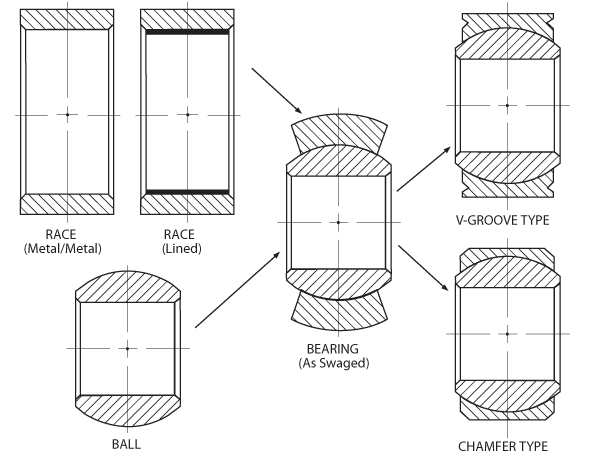
Swaged sphericals - standard assembly method.
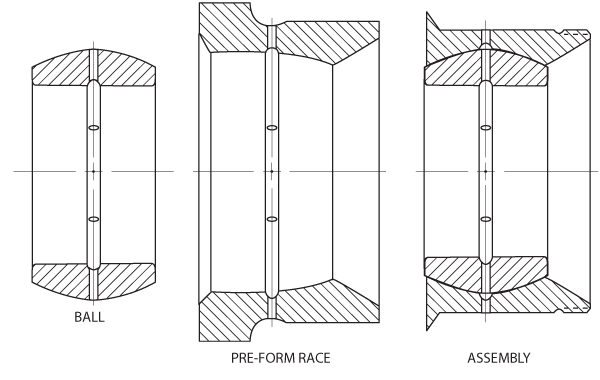
Swaged sphericals - pre-form design assembly.
Loader Slot
A loader slot bearing is a non-swaged bearing type. The spherical race I.D. is fully machined, case hardened, and lapped. The race has entry slots machined 180° apart into one face of the race to facilitate assembly of the ball. Attributes of this design are:
- Non-swageable race materials can be used.
- Race spherical I.D.’s can be chemically or physically enhanced to improve wear resistance (ie: nitriding or plating).
- Ball replaceability; generally, the ball wears at a more rapid rate than the hardened race spherical I.D.. The loader slot design allows for the ball to be replaced without removing the bearing assembly from the housing. The net effect is reduced down time and maintenance cost due to on-wing repair.
- Race spherical I.D. can be lapped to a very close tolerance to provide excellent ball-to-race conformity.
- When required, the race can be designed with the sphere/slot entry intersection off-center. This design provides for a slight entry slot/ball interference (sometimes referred to as pop-in). This prevents the ball from falling out of the slot during shipping or handling.
- Entry slots should be oriented 90° with respect to the load. This bearing is generally recommended for applications with vibratory or static loads where there is small relative motion between the ball and race. This bearing is not recommended for applications where there is moderate to high relative motion between the ball and race under load. Under these conditions for long durations, these bearings exhibit high friction and excessive wear.
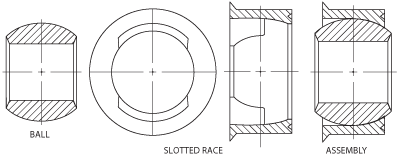
Loader slot bearing.
Split Ball Spherical Bearings
Split ball spherical bearings are designed to offer similar advantages to grease lubricated load slot bearings. Unlike the load slot bearing, there is no loss of bearing area due to the entry slot. Split ball designs are intended for applications only where pin rotation will occur. There is no clamping on the ball faces.
The split ball is machined and ground in matched sets with a "zero" gap at the separation plane. The ball is typically a copper alloy. Like the load slot bearing, the race is fully machined, wear surface hardened, then finished with a lap operation. Because the race is the harder member, wear is intended to occur on the ball. The split ball feature allows the ball to be replaced "on the aircraft" in certain applications.
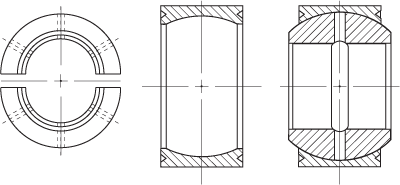
Two-piece, split-ball spherical bearing.
Fractured Race Bearings
Fractured race bearings are an alternative to loader slot bearings. In this design the race is ground all over (including the race I.D.), notched, and transversely fractured in half.
This bearing has full ball-to-race contact, which reduces stress and results in reduced wear, particularly in high vibration applications. This type of bearing must utilize a very hard race to facilitate the fracturing process.
The advantage of fractured race bearings is that no bearing area is sacrificed. PTFE liners are not usually used in these bearings.
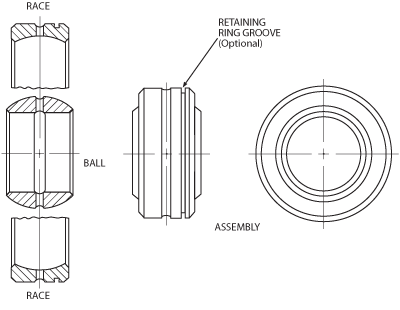
Fractured race bearing.
Split Race Bearings
Split race bearings have a race that is circumferentially or transversely split. The resulting two half races are placed around the ball and retained by a housing.
Split race designs are used principally on larger bearings when installation in the application is difficult. These bearings can be made of any material and can incorporate a PTFE liner.
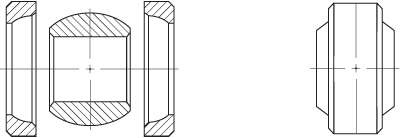
Snap-Assembled Bearings
Snap-Assembled bearings, sometimes referred to as “snap-in,” are generally designed with a relatively large diameter, thin cross section, and narrow ball geometries. NHBB uses a race width to ball diameter ratio of .20 as a design consideration for this bearing configuration. Snap-assembly is accomplished by deflecting the race, ball, or both within their elastic limits to allow entry of the ball into the race. This type of design is generally used only when all other methods are impractical or impossible due to problem geometry or processing restraints.
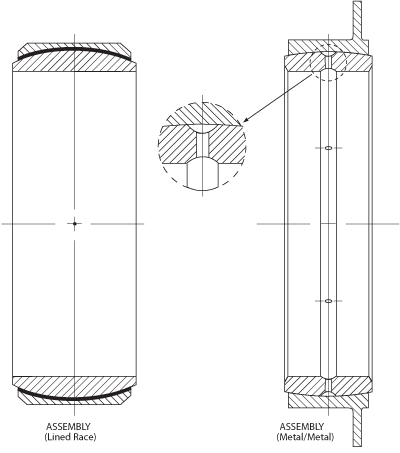
Snap-assembled bearing.
Two-Piece Coined Rod Ends
NHBB manufactures two- and three-piece rod ends. Two-piece rod ends consist of a rod end body and a ball. The three-piece rod end consists of a two-piece spherical bearing cartridge pressed and staked into a machined rod end body.
The coined two-piece rod end is used when maximum strength in a given envelope is required. The coined two-piece rod end has better ball-to-race conformity than a “mohawk rod end,” particularly in the area just above the shank. PTFE liner installation is not possible for this type of rod end.
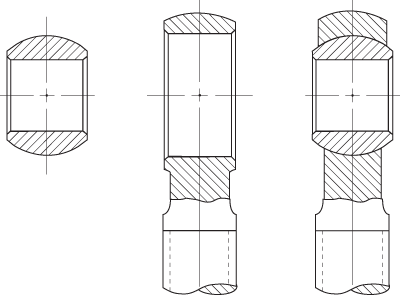
Two-piece swage-coined rod end.
Two-Piece Mohawk Rod Ends
The two-piece Mohawk rod end is used for lightly loaded applications. However, head strength is sacrificed. PTFE liners are often used in this type of construction.
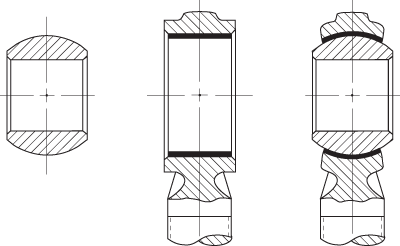
Two-piece mohawk rod end.
Three-Piece Rod Ends
The three-piece rod end is the standard and preferred construction at NHBB. It offers the best formed ball-to-race conformity and moderate strength. During manufacture, a swaged spherical bearing cartridge is installed in a rod end body and usually retained by staking. The most popular means of retention utilizes the V-groove. The V-groove is machined into the bearing cartridge race face. The lip formed by this groove is flared over a chamfer in the housing. This method provides moderate thrust capacity and allows a worn bearing to be removed without damaging the housing. Three-piece rod ends may be PTFE lined.
A three-piece housing staked rod end configuration is generally used only when other factors are present. Such factors may include non-ductile race material, insufficient race face area to facilitate a V-groove, or economy of production.
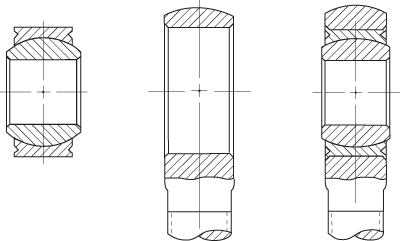
Three-piece V-groove staked rod end.
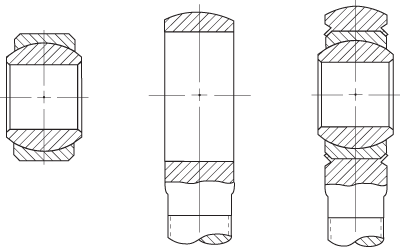
Three-piece housing staked rod end.
Loader Slot and Split Ball Rod Ends
Loader slot rod ends and split ball rod ends provide alternative two-piece precision ground ball and body construction with the same design benefits of the comparable spherical design. Maximum body strength and bearing projected area is offered by the split ball design because of the omission of the loader slot
A three-piece housing staked rod end configuration is generally used only when other factors are present. Such factors may include non-ductile race material, insufficient race face area to facilitate a V-groove, or economy of production.
Track Rollers
NHBB manufactures track rollers as an alternative to needle roller bearings. The PTFE composite track roller can be designed to existing needle roller envelope dimensions. The track roller is made up of an outer member (roller), which slides over an inner member (bushing or stud). These two members sandwich a low friction, low wearing PTFE composite material. The inner and outer members are retained in the axial direction by thrust washers that are either press fit, staked or welded onto the inner member to support axial loading.
Design features of NHBB’s track rollers are high load carrying capability, resistance to many corrosive chemicals and environmental contaminants, and the ability to absorb heavy vibratory loads. Sliding surface track rollers offer improved bearing performance over needle rollers with respect to these design features.
While this product may be utilized in many rolling applications, it is not recommended for high rotational speeds or where low needle roller type frictional characteristics are required. For additional information, please contact NHBB Applications Engineering Department.
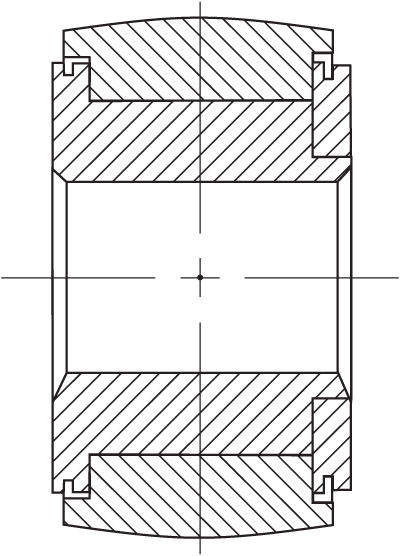
Track roller.
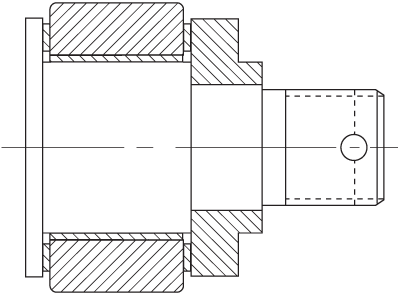
Track roller.
Sleeve Bearings (Self-Lubricating)
Military Series
NHBB's AD and ADLF series of self-lubricating sleeve bearings are approved for procurement to M81934/1 and M81934/2 P/N series, respectively.
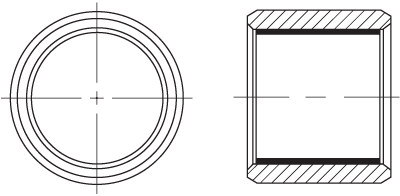
Plain (AD) self-lubricating sleeve bearing.
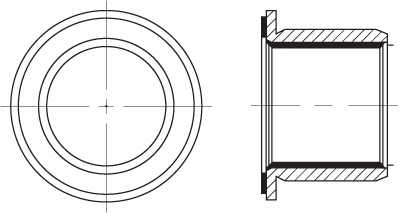
Flanged (ADLF) self-lubricating sleeve bearing.

